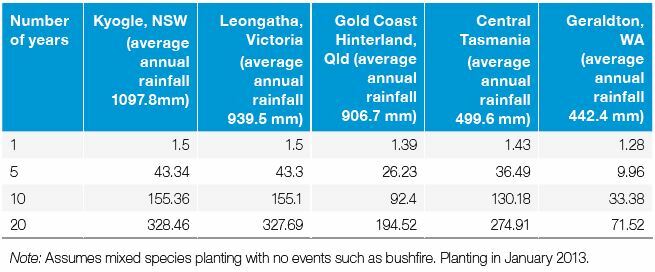8.3.1 Sequestration from environmental plantings
As an example, Table 8.2 summarises information on cumulative abatement for 1 hectare of environmental planting. Abatement varies considerably across regions, influenced by geography and rainfall.
Table 8.2: Cumulative abatement from 1 hectare of environmental planting (t CO2-e) |
|
Source: Clean Energy Regulator / Rainfall data taken from Bureau of Meteorology |
8.3.2 Potential revenue from environmental planting
Table 8.3 summarises the revenue (over 20 years) that could be earned from this abatement, assuming a range of ACCU prices.
Please note, an advance payment worth up to $5,000 is currently available through a pilot program for eligible Emissions Reduction Fund (ERF) projects to help with upfront costs of soil sampling. More details HERE.
Table 8.3: Illustrative potential revenue over 20 years for 1 hectare of environmental planting |
|
Note: Excludes 5% risk of reversal buffer. Note that these are not discounted
|
Explore the full Workshop Manual: The business case for carbon farming: improving your farm’s sustainability (January 2021)
Read the report
RESEARCH REPORTS
1. Introduction: background to the business case
This chapter lays out the basic background and groundwork of the manual
RESEARCH REPORTS
1.2 Being clear about the reasons for participating
Introduction: background to the business case
RESEARCH REPORTS
1.4 Working through the business case for carbon farming
Introduction: background to the business case
RESEARCH REPORTS
1.5 Factors determining project economics
Introduction: background to the business case
RESEARCH REPORTS
1.8 Important features of the business case
Introduction: background to the business case
RESEARCH REPORTS
2. How carbon is farmed under the ERF
This chapter considers in detail the activities that constitute carbon farming
RESEARCH REPORTS
2.5 Carbon farming under the Emissions Reduction Fund
How carbon is farmed under the ERF
RESEARCH REPORTS
3. The policy context and the price of ACCUs
This chapter takes a broad look at the policy context for carbon farming
























